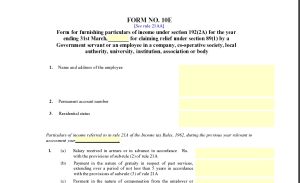Choosing between the Old and New Tax Regime as per Budget 2025 feels a lot like choosing between two roads to your financial destination. Both can get you there, but the smoother path depends on how you plan your journey. While the Old Tax Regime offers numerous deductions and exemptions, the New Tax Regime provides simplicity with lower tax rates. But which is truly better for the salaried class? Let’s explore this question step-by-step and help you make an informed, smart decision for F.Y.2025-26.
Table of Contents
ToggleTable of Contents
| Sr# | Headings |
| 1 | Understanding the Basics of Old and New Tax Regimes |
| 2 | Key Differences Between the Regimes |
| 3 | Tax Slabs Comparison: Old vs New Regime (FY 2025-26) |
| 4 | Deductions and Exemptions Explained |
| 5 | Who Benefits Most from the Old Tax Regime? |
| 6 | When Should You Choose the New Tax Regime? |
| 7 | Impact of Budget 2025 on the Salaried Class |
| 8 | Standard Deduction and Rebate Updates for FY 2025-26 |
| 9 | Real-Life Examples: 6L, 10L, and 15L Salaries |
| 10 | Pros and Cons of Both Regimes |
| 11 | Government’s Push Towards the New Regime |
| 12 | Common Mistakes While Choosing a Tax Regime |
| 13 | How to Switch Between Regimes |
| 14 | Automatic Income Tax Calculator – Simplify Your Decision |
| 15 | Conclusion and Final Thoughts |
| 16 | FAQs |
1. Understanding the Basics of Old and New Tax Regimes
To begin with, the Old Tax Regime rewards those who invest wisely. You can claim several deductions, such as HRA, LTA, 80C (LIC, PPF, ELSS), 80D for medical insurance, and home loan interest. These reduce your taxable income and can significantly lower your tax liability.
In contrast, the New Tax Regime removes most deductions but compensates with lower tax rates. It’s a simplified system ideal for those who prefer less paperwork and minimal planning.
In short, the Old Regime promotes disciplined saving, while the New Regime emphasises simplicity and speed.
2. Key Differences Between the Two Regimes
The Old Regime functions like a traditional savings plan — rewarding those who plan and invest. On the other hand, the New Regime is like a digital wallet — simple, fast, and hassle-free.
Under the Old Regime, deductions and exemptions were plentiful. However, in the New Regime, you get limited benefits but cleaner calculations. Choosing the right one depends on your financial habits, income, and comfort level with tax planning.
3. Tax Slabs Comparison: Old vs New Regime (FY 2025-26)
| Income Range (₹) | Old Regime Tax Rate | New Regime Tax Rate |
| 0 – 2,50,000 | Nil | Nil |
| 2,50,001 – 5,00,000 | 5% | 5% (3L – 6L) |
| 5,00,001 – 10,00,000 | 20% | 10% (6L – 9L) |
| 10,00,001 – 12,00,000 | 30% | 15% (9L – 12L) |
| 12,00,001 – 15,00,000 | 30% | 20% (12L – 15L) |
| Above 15,00,000 | 30% | 30% |
With the New Regime, you pay lower tax rates at most income levels, making it appealing for those without many deductions.
4. Deductions and Exemptions Explained
Old Tax Regime Benefits
- Section 80C: Investments in LIC, PPF, ELSS, PF (up to ₹1.5 lakh).
- Section 80D: Medical insurance premiums.
- HRA and LTA: Rent and travel exemptions.
- Standard Deduction: ₹50,000 for salaried individuals.
- Home Loan Interest: Deduction on interest paid.
New Tax Regime Limitations
- Only Standard Deduction: ₹75,000 (after Budget 2025).
- No HRA, 80C, or 80D deductions available.
Thus, if you have investments and loans, the Old Regime may be more profitable.
5. Who Benefits Most from the Old Tax Regime?
If you are a salaried employee who:
- Invests regularly in tax-saving schemes,
- Pays rent or home loan, and
- Has family medical insurance,
Then the Old Regime might work better for you. It allows multiple exemptions that can dramatically lower your tax burden.
6. When Should You Choose the New Tax Regime?
If you prefer simplicity over paperwork, then the New Regime suits you. It’s perfect for those who:
- Have fewer deductions,
- Want quick and clear calculations, and
- Prefer hassle-free tax filing.
Think of it like taking an express train — no stops, just straight to your destination!
7. Impact of Budget 2025 on Salaried Class
Budget 2025 introduced several favourable changes. The Standard Deduction under the New Regime increased from ₹50,000 to ₹75,000, offering relief to middle-class earners. Moreover, the Section 87A rebate now allows tax-free income up to ₹12.75 lakh — a huge boost for lower-income groups.
These updates make the New Regime more attractive, especially for those with moderate salaries and fewer deductions.
8. Standard Deduction and Rebate Updates for FY 2025-26
- Old Regime: Standard deduction remains ₹50,000.
- New Regime: Standard deduction increased to ₹75,000.
- Section 87A Rebate: Taxpayers with income up to ₹12.75 lakh pay zero tax under the New Regime.
Such benefits show the government’s intention to make taxation simpler and fairer.
9. Real-Life Examples: 6L, 10L, and 15L Salaries
For ₹6 Lakh Income
If you have no major deductions, the New Regime offers simplicity and lower tax rates. But if you invest ₹1.5 lakh under 80C, the Old Regime saves you more.
For ₹10 Lakh Income
With deductions above ₹2.5 lakh (HRA, 80C, 80D), the Old Regime wins. Otherwise, the New Regime might result in lower taxes.
For ₹15 Lakh Income
Those with limited deductions should opt for the New Regime, but heavy investors will find better savings in the Old Regime.
10. Pros and Cons of Both Regimes
| Feature | Old Regime | New Regime |
| Tax Slabs | Higher rates | Lower rates |
| Deductions | Many available | Only standard deduction |
| Ease of Filing | More complex | Simplified |
| Best For | Investors and planners | Simple filers |
| Flexibility | High | Limited |
Ultimately, your financial habits decide which regime works best.
11. Government’s Push Towards the New Regime
The New Regime is now the default tax option for FY 2025-26. To choose the Old Regime, taxpayers must file Form 10-IEA every year.
The government’s goal is clear — reduce complexity, promote transparency, and make tax filing easier for every Indian.
12. Common Mistakes While Choosing Tax Regime
- Not comparing both regimes before filing.
- Ignoring available deductions like HRA or 80C.
- Assuming lower rates always mean lower taxes.
- Forgetting to review your choice yearly.
Avoid these mistakes to make an informed decision.
13. How to Switch Between Regimes
You can switch between the Old and New Regimes annually while filing your ITR. Salaried employees can inform their employers before the start of each financial year.
This flexibility lets you adapt based on changing income, investments, or financial goals.
14. Automatic Income Tax Calculator – Simplify Your Decision
To help taxpayers decide easily, you can now download the Automatic Income Tax Calculator All-in-One in Excel for FY 2025-26.

Features Include:
- Prepares tax computation as per Budget 2025.
- Works for both Govt and Non-Govt Employees.
- Automatically calculates HRA Exemption and Tax Arrears Relief (U/s 89(1)).
- Includes Form 10E, Form 16 (Part A & B), and Automatic Salary Sheet.
This tool saves time, ensures accuracy, and supports smart tax planning for every salaried person.
15. Conclusion and Final Thoughts
In summary, there’s no one-size-fits-all answer to which regime is better. The Old and New Tax Regime as per Budget 2025, offer unique advantages.
If you’re an investor who loves maximising deductions, stick with the Old Regime. But if you prefer an effortless, simplified tax process, go for the New Regime. Either way, using the Automatic Excel Income Tax Calculator ensures you make the smartest, data-backed choice.
FAQs
- Which tax regime is better for salaried employees in FY 2025-26?
If you have multiple deductions (HRA, 80C, 80D), the Old Regime is better. If not, the New Regime is simpler and may save more tax. - What is the new standard deduction for salaried employees in FY 2025-26?
Under Budget 2025, the New Regime offers a standard deduction of ₹75,000, while the Old Regime remains at ₹50,000. - Can I switch between the Old and New Regime every year?
Yes, salaried individuals can choose their regime each financial year before filing their income tax return. - Is the New Regime mandatory for everyone?
No, but it is now the default regime. You must file Form 10-IEA to continue with the Old Regime. - How can I calculate my tax under both regimes easily?
You can use the Automatic Income Tax Calculator All-in-One in Excel to compare tax liability under both regimes quickly and accurately.





